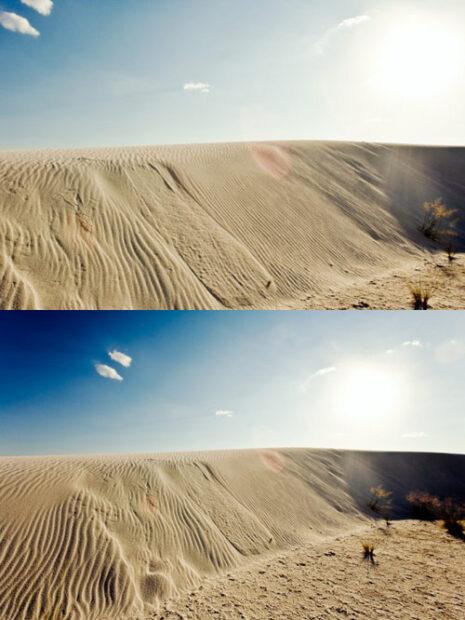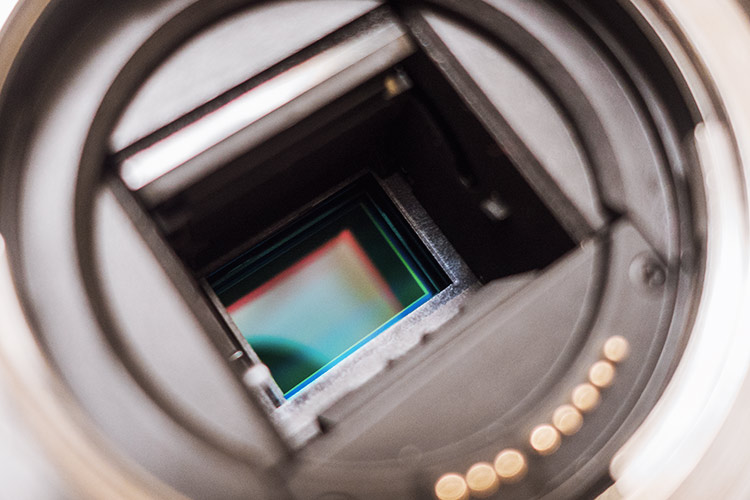We may earn a commission when you purchase through affiliate links. Learn more.
35mm equivalent focal length tells us what the field of view will be when we use a certain lens on a camera with a certain sensor size. Before digital photography came along and introduced numerous sensor sizes, a frame of 35mm film was always the same size (36×24 mm). If you attached a 28mm lens to your 35mm film SLR camera, the 28mm lens would function as a wide angle lens, allowing you to capture a wide portion of your scene. On a digital SLR or mirrorless camera, only full frame sensors which are the same size as a 35mm film frame allow you to take advantage of a lens’s full angle of view.
On an entry-level DSLR camera like the Canon T6i which has an APS-C size sensor that’s about 40% smaller than a full frame sensor, when we use the same 28mm lens, the smaller sensor only records a cropped area of the total scene viewed by the lens. This smaller field of view means that the 28mm lens when used with an APS-C size sensor captures the same scene as if we were using a 45mm lens on a full frame camera like the Canon 5Ds. We can easily calculate the effect of this so called crop factor (sometimes referred to as the lens multiplication factor or lens conversion factor) by multiplying how much larger a full frame sensor is than the sensor on the camera in question (1.5x, 1.6x, 2.0x, etc) by the focal length of a lens. This basic equation will tell us what the lens’s 35mm equivalent focal length will be.
Although manufacturing costs of digital sensors continue to decrease, full frame sensors which have larger photosites (the light collecting sites often referred to as pixels) are still more expensive to produce, meaning that they’re usually only found in high-end camera’s with professional features like the Sony A7r II or Nikon D4s.
Angle of view and field of view are two really similar concepts that are frequently referred to incorrectly when talking about camera lenses and sensor crop factors.
A lens’s angle of view is a fixed measurement that describes how wide of an angle a particular focal length of lens can see. Where it gets tricky is when we introduce field of view, which is a measurement of how wide of an angle a camera’s sensor can capture using a particular focal length of lens.
To explain it better, let’s use a telescope as an example again. Imagine that you’re looking through a telescope at downtown. You can see 1st Street on the left and 10th Street on the right. What would happen if you placed a rectangular black frame over the telescope’s viewfinder, reducing the size of your viewfinder? Instead of being able to see from 1st Street to 10th Street, now you can only see from 3rd Street to 7th Street. The telescope’s focal length and angle of view hasn’t changed, but your field of view is now narrower.
Sensors smaller than full-frame size have a reduced field of view — even though the lens is still admitting light from the edges of the scene, the smaller sensor is only able to record the center of the scene that it can see. What causes people to think that angle of view and field of view are the same thing is the fact that on a full frame camera the value of both angle and field of view for a lens are the same. It’s only once you use that lens on a camera with a different sensor size that the values change.
Crop factors include 1.5x for Nikon’s APS-C format sensors found in the Nikon D3300, 1.6x for Canon’s APS-C format sensors like the Canon SL1, and 2x for Micro Four Thirds format sensors like the Olympus OM-D E-M1.
 A greater crop factor, accompanied by a narrower field of view might be desirable for wildlife photographers, allowing them to fill more of their frame with their subject but for landscape photographers though, a crop factor is often not a desirable thing, since it means that less of the scene can be captured. In this image to the left, you can see what we mean. Photographed using a Canon 16-35mm f/2.8 L lens set to 16mm, the top image is what the photo might look like were it shot using a Canon T6i, which has an APS-C sensor and a 1.6x crop factor. Less of the scene is visible, even when using the lens at its 16mm focal length since the smaller sensor’s field of view gives this lens a 25mm equivalent focal length, and the vastness of the desert landscape can’t be truly appreciated from this vantage point. The lower image is what the photo would look like, were it taken with a Canon 5Ds, which has a full frame sensor and thus no crop factor. At 16mm, the lens is able to function as a true ultra-wide angle lens, capturing a much wider field of view.
A greater crop factor, accompanied by a narrower field of view might be desirable for wildlife photographers, allowing them to fill more of their frame with their subject but for landscape photographers though, a crop factor is often not a desirable thing, since it means that less of the scene can be captured. In this image to the left, you can see what we mean. Photographed using a Canon 16-35mm f/2.8 L lens set to 16mm, the top image is what the photo might look like were it shot using a Canon T6i, which has an APS-C sensor and a 1.6x crop factor. Less of the scene is visible, even when using the lens at its 16mm focal length since the smaller sensor’s field of view gives this lens a 25mm equivalent focal length, and the vastness of the desert landscape can’t be truly appreciated from this vantage point. The lower image is what the photo would look like, were it taken with a Canon 5Ds, which has a full frame sensor and thus no crop factor. At 16mm, the lens is able to function as a true ultra-wide angle lens, capturing a much wider field of view.
For the average amateur photographer, the crop factor is a minor issue most of the time, but for professionals who must get the shot right the first time, it can be a more relevant factor to consider when selecting a camera body.

